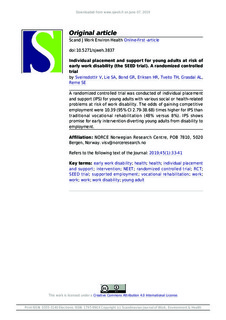| dc.contributor.author | Sveinsdottir, Vigdis | |
| dc.contributor.author | Lie, Stein Atle | |
| dc.contributor.author | Bond, Gary R. | |
| dc.contributor.author | Eriksen, Hege Randi | |
| dc.contributor.author | Tveito, Torill Helene | |
| dc.contributor.author | Grasdal, Astrid | |
| dc.contributor.author | Reme, Silje Endresen | |
| dc.date.accessioned | 2020-02-04T12:32:27Z | |
| dc.date.available | 2020-02-04T12:32:27Z | |
| dc.date.created | 2019-10-25T10:38:31Z | |
| dc.date.issued | 2019 | |
| dc.identifier.citation | Scandinavian Journal of Work, Environment and Health. 2019, 46 (1), 50-59. | nb_NO |
| dc.identifier.issn | 0355-3140 | |
| dc.identifier.uri | http://hdl.handle.net/11250/2639572 | |
| dc.description | This work is licensed under a Creative Commons Attribution 4.0 International License. | nb_NO |
| dc.description.abstract | Objectives Individual placement and support (IPS) is an effective approach for helping people with severe mental illness gain employment. This study aimed to investigate if IPS can be effectively repurposed to support young adults at risk of early work disability due to various social and health related problems. Methods A randomized controlled trial including 96 young adults (18‒29 years; 68% men) was conducted in Norway. Participants were not in employment, education, or training, received temporary benefits due to social or health-related problems, and were eligible for traditional vocational rehabilitation (TVR). Participants were randomized to IPS (N=50) or TVR (N=46). Self-reported data were collected at baseline and at 6- and 12-months follow-up. The primary outcome was obtaining any paid employment in the competitive labor market during follow-up. Secondary outcomes were physical and mental health, well-being, coping, alcohol consumption, and drug use. Results Significantly more IPS participants obtained competitive employment compared to TVR participants during 12-months follow-up (48% versus 8%; odds ratio 10.39, 95% confidence interval 2.79‒38.68). The IPS group reported significantly better outcomes than the TVR group in subjective health complaints, helplessness, and hopelessness. In post hoc analyses adjusted for baseline and missing data, the IPS group reported significantly better outcomes on these measures in addition to level of disability, optimism about future well-being, and drug use. Conclusions IPS is effective for young adults at risk of early work disability. IPS was superior to TVR in increasing competitive employment and promoted improvements in some non-vocational outcomes. IPS services should be offered to improve employment rates in this vulnerable group. | nb_NO |
| dc.language.iso | eng | nb_NO |
| dc.rights | Navngivelse 4.0 Internasjonal | * |
| dc.rights.uri | http://creativecommons.org/licenses/by/4.0/deed.no | * |
| dc.title | Individual placement and support for young adults at risk of early work disability (the SEED trial). A randomized controlled trial | nb_NO |
| dc.type | Journal article | nb_NO |
| dc.type | Peer reviewed | nb_NO |
| dc.description.version | publishedVersion | nb_NO |
| dc.source.pagenumber | 50-59 | nb_NO |
| dc.source.volume | 46 | nb_NO |
| dc.source.journal | Scandinavian Journal of Work, Environment and Health | nb_NO |
| dc.source.issue | 1 | nb_NO |
| dc.identifier.doi | 10.5271/sjweh.3837 | |
| dc.identifier.cristin | 1740517 | |
| cristin.unitcode | 222,56,3,0 | |
| cristin.unitname | Institutt for helse-, sosial- og velferdsfag | |
| cristin.ispublished | true | |
| cristin.fulltext | original | |
| cristin.qualitycode | 1 | |

